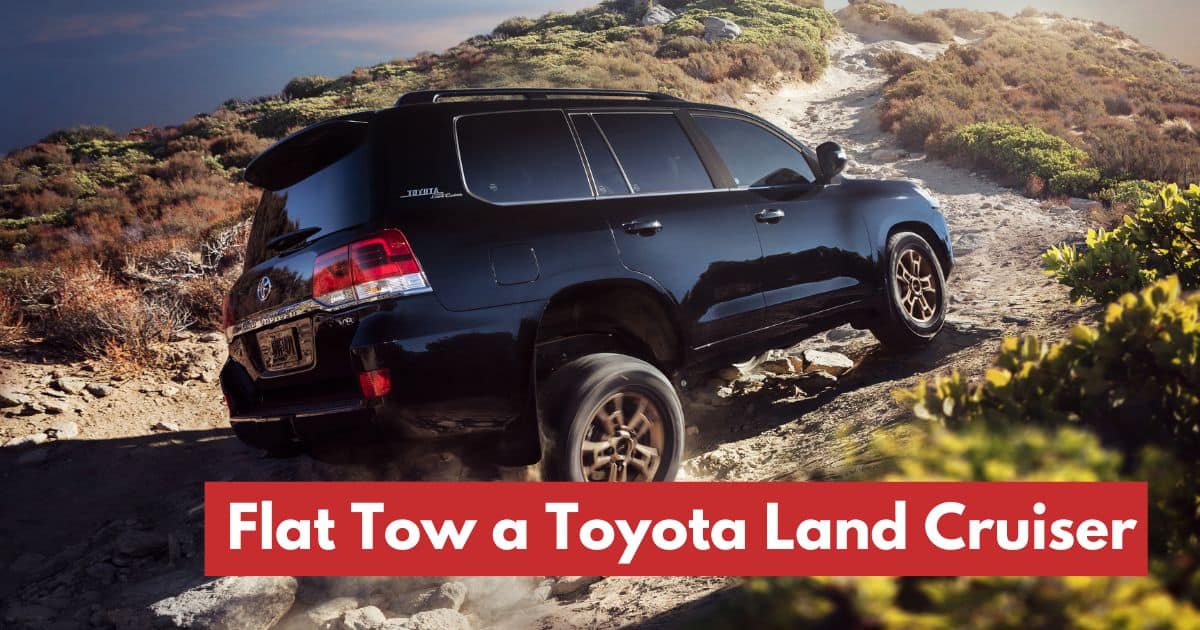Can You Flat Tow a Toyota Land Cruiser? Essential Guide for Off-Road Enthusiasts
Wondering if you can flat tow your Toyota Land Cruiser? It’s a common question for owners of this iconic off-road vehicle. Toyota Land Cruisers cannot be safely flat towed due to their drivetrain design. Flat towing could cause serious damage to the transmission and other components.

The Land Cruiser’s full-time four-wheel drive system is not designed for flat towing behind another vehicle. This 4WD setup helps give the Land Cruiser its legendary off-road capability, but it also means the drivetrain is always engaged. Towing it with all four wheels on the ground could lead to major mechanical issues.
If you need to tow your Land Cruiser, you’ll want to use a trailer or flatbed truck instead. This keeps all four wheels off the ground and protects the drivetrain from potential damage. While not as convenient as flat towing, it’s the safest way to transport your Toyota Land Cruiser over long distances.
Key Takeaways
- Toyota Land Cruisers can’t be safely flat towed
- Using a trailer or flatbed is recommended for towing
- Flat towing risks serious damage to the drivetrain
Can You Flat Tow a Toyota Land Cruiser?
Flat towing a Toyota Land Cruiser depends on several factors. The model year, transmission type, and drivetrain configuration all play a role in whether you can safely tow your Land Cruiser behind an RV or other vehicle.
Manufacturer Specifications
Toyota doesn’t officially recommend flat towing for most Land Cruiser models. This is mainly due to the complex 4WD systems and automatic transmissions in modern Land Cruisers. Flat towing can cause damage to these components if not done correctly.
For older manual transmission models, flat towing may be possible. However, you should always check your specific vehicle’s owner’s manual for guidance. Some Land Cruisers may require additional steps, like disconnecting the driveshaft, to prevent transmission damage during towing.
If you’re considering flat towing a Toyota, it’s crucial to research your exact model and year. Don’t assume that because one Land Cruiser can be flat towed, all of them can.
Model Year Considerations
Land Cruiser towing capabilities vary greatly by model year. Older models from the 1980s and earlier, especially those with manual transmissions, are often easier to flat tow. These simpler mechanical designs are less prone to damage from flat towing.
Newer Land Cruisers, particularly those from the late 1990s onward, are more challenging to flat tow. Their advanced 4WD systems and computerized components make flat towing risky without special preparation.
For example, a 1985 Land Cruiser FJ60 with a manual transmission might be flat-towable with minimal preparation. In contrast, a 2020 Land Cruiser would likely require significant modifications or a tow dolly to safely transport.
Aftermarket Solutions
If your Land Cruiser isn’t flat-towable out of the box, don’t worry. There are aftermarket solutions available. Driveshaft disconnect devices can allow flat towing by preventing transmission damage. These systems let you disconnect the driveshaft without crawling under the vehicle.
Lube pumps are another option. They circulate transmission fluid while towing, preventing damage from lack of lubrication. Some Land Cruiser owners also install transmission coolers for added protection during long tows.
Remember, these modifications can be complex and may affect your vehicle’s warranty. Always consult with a professional before making any changes to your Land Cruiser’s drivetrain. While aftermarket solutions can make flat towing possible, they’re not without risks and added costs.
Understanding Flat Towing
Flat towing is a popular method for hauling vehicles behind RVs or larger trucks. It’s important to know how it works and when to use it. Let’s look at what flat towing is, how it compares to other methods, and its pros and cons.
Defining Flat Towing
Flat towing means pulling a car with all four wheels on the ground. You attach the vehicle to a tow bar on your RV or truck. This method is also called “four-down towing” or “dinghy towing.”
To flat tow, you need special equipment. This includes a tow bar, base plate, and safety cables. You also need to set up the towed car correctly. Some cars need extra steps, like disconnecting the driveshaft.
Not all cars can be flat towed. You need to check your owner’s manual or ask a dealer. Some vehicles like certain Jeeps are made for easy flat towing.
Flat Towing vs. Other Towing Methods
Flat towing differs from other ways to tow cars. Here’s how it compares:
- Trailer towing: You put the whole car on a trailer. This works for any car but needs a big trailer.
- Dolly towing: The front wheels are on a small trailer. The back wheels roll on the road.
- Flat towing: All four wheels are on the ground.
Each method has its place. Flat towing is often easier for long trips. You don’t need a big trailer, and it’s simpler to set up and take down.
But not all cars can be flat towed. Some need to use a trailer or dolly to avoid damage to their transmission or drivetrain.
Benefits and Challenges of Flat Towing
Flat towing has several benefits:
- It’s easy to set up once you have the right gear.
- You can quickly unhook your car at stops.
- It takes up less space than a trailer when parked.
- It’s often cheaper than buying and storing a trailer.
But there are also challenges:
- Not all cars can be flat towed safely.
- You need to buy and install special equipment.
- Some cars need extra steps before towing.
- It can be hard on your car’s tires and components.
Before you decide to flat tow, check if your car is made for it. Look in your manual or ask a dealer. Also, think about how often you’ll tow and what kind of trips you’ll take. This will help you choose the best towing method for your needs.
